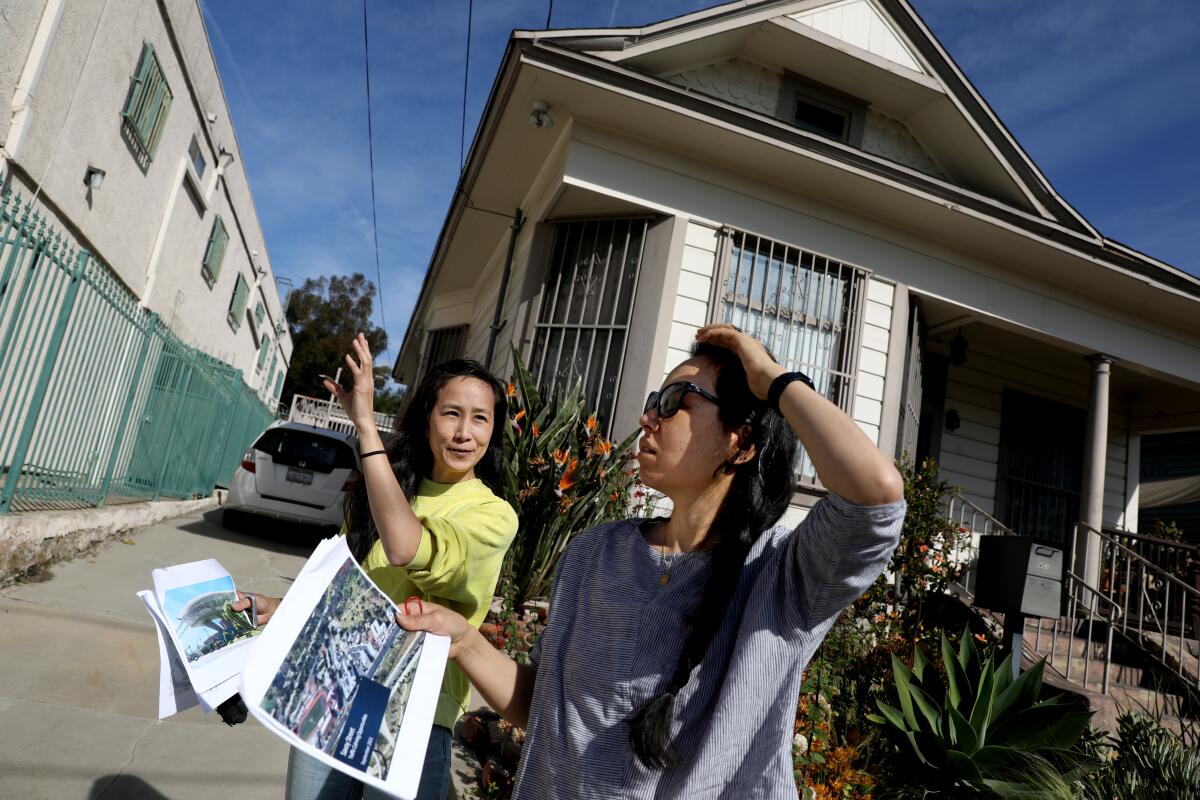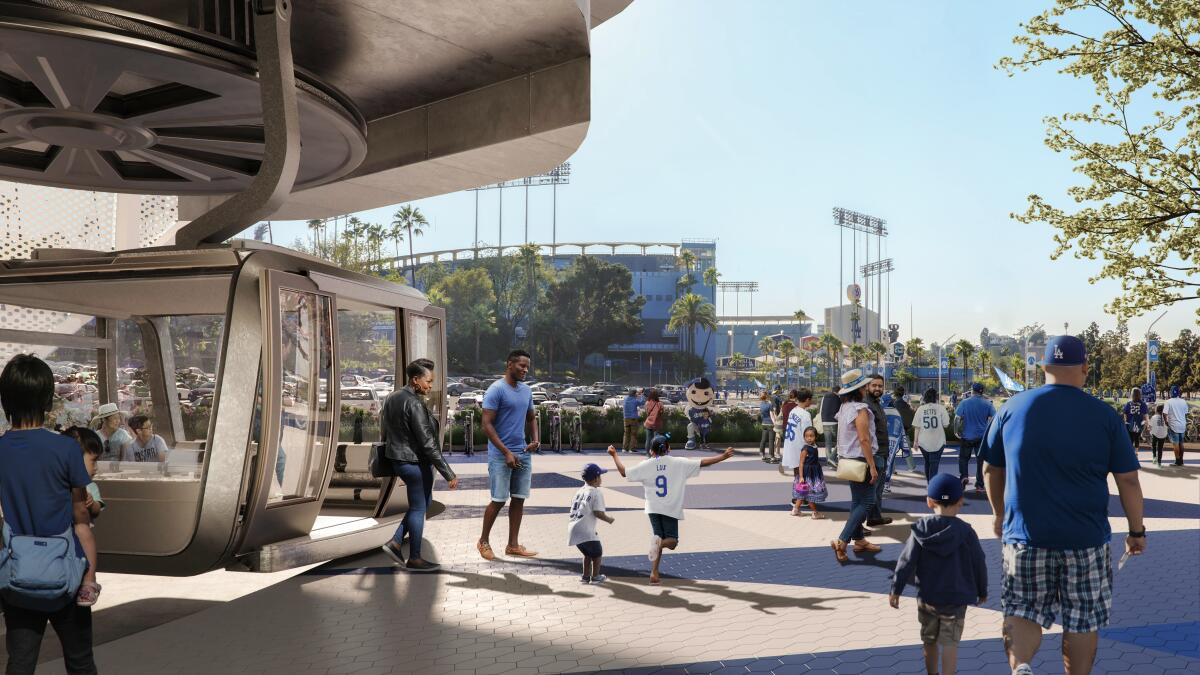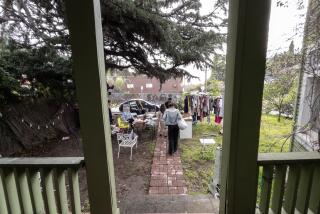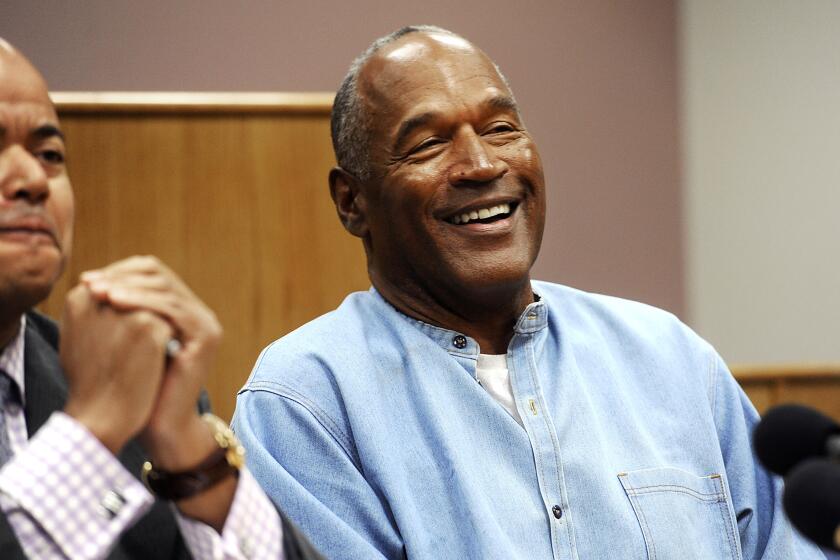Aerial gondola at Dodger Stadium sparks fears of accelerated gentrification

With their Chinatown home boxed in by a freeway entrance, apartment buildings, a high school and a major boulevard to downtown Los Angeles, Phyllis and Tany Ling get the full cacophony of urban life from every direction but up.
Never could the sisters have imagined a project proposed directly above their home.
Metro is helping to plan an aerial gondola system to whisk baseball fans and concertgoers from Union Station to Dodger Stadium in what it says would be a mere seven-minute trip. Funded by former Dodgers owner Frank McCourt, the project would run about 40 feet above the Lings’ century-old Victorian cottage — meaning that every 30 seconds on game days, some 40 people packed in a tram would pass outside their living room window.
“It’s just another way that we can’t own our neighborhood and feel safe and quiet here because literally you have something flying over your house all day long, forever, I guess,” said Tany Ling, a singer who offers private lessons at the home she and her sister bought in 2012.

McCourt entities are buying up properties in the neighborhood, but the Lings don’t want to move. They started StoptheGondola.org to fight the project.
“My friends who are more business-minded tell me to just sell and move somewhere else, maybe out of state. But we don’t want to move,” said Phyllis. “I don’t know if we can stop it.”
This week, the sisters got some serious backup. The California Endowment, a charitable foundation, filed a writ of mandate in Los Angeles County Superior Court contending the county’s Metropolitan Transportation Authority fast-tracked the project without public vetting in a “sweetheart deal” with McCourt’s Los Angeles Aerial Rapid Transit Technologies. The nonprofit, which works to preserve the health of communities, is asking a judge to halt Metro’s efforts to ferry the project through the planning process.
California Endowment files legal challenge to former Dodger owner Frank McCourt’s proposed gondola project from Union Station to the stadium.
“The Gondola Project provides no discernible benefits to Metro, to Angeleno taxpayers, or to the broader community,” the court filing said. “Although the need for increased transit infrastructure is significant, the Gondola Project as proposed functions as a private tourist attraction, not a public transportation line to serve Metro riders.”
The endowment argues that the electric-powered gondola is merely a “for-profit income generator” for McCourt’s company.
Backed early on by Mayor Eric Garcetti, the unusual deal came together under Metro’s Office of Extraordinary Innovation, created in 2015 to help the hulking bureaucracy — mostly focused on bus routes, freeway expansions and rail projects — to tap into private markets where technologies are changing mobility in the way ride-hailing service Uber did. The office has birthed small projects such as Metro Micro, an Uber-like service run by Metro. But this is the first time Metro will take the lead on a privately funded public transportation project of this scale.

Metro declined to comment on the pending litigation. McCourt’s gondola company, which goes by the acronym LA ART, said it has yet to see the petition, but spokesperson Jennifer Rivera said “any allegation that appropriate procedures were not followed is without merit.”
McCourt sold the Dodgers in 2011, but retained half interest in the 130 acres of parking around the stadium where the terminal would stand.
“Frank McCourt has a long history of being solutions oriented. He lived the Dodger traffic and understands the congestion and he believes that aerial transit is a proven technology that’s efficient and provides clean transportation,” she said. The route will not displace any residents and it runs mostly along public property and city streets, she noted.
Pitching the gondola as a congestion-avoiding alternative for commuters heading to Dodgers games, LA ART points out that Dodger Stadium is one of just three Major League Baseball stadiums without a permanent transit connection. Game days often choke the nearby neighborhoods of Solano Canyon, Chinatown and Echo Park.
The system could ferry 5,000 people an hour, alleviating the need for them to drive to the stadium. A free shuttle also runs to the 56,000-seat stadium, which gondola opponents say is a better option. But Metro hopes the connection to Union Station — where several rail and bus lines converge — and a stop near the Chinatown station would encourage more commuters to take public transit.
“Anything that can alleviate some of that traffic would be great. Opening day last year traffic was insane,” said Darrell Meade, who lives about half a mile from Vin Scully Avenue, one of the main routes to the stadium. When the Dodgers are playing, he said, it can take 15 minutes to drive a few blocks.
LA ART has yet to announce what a ticket would cost or who would run the system. But Rivera said the system would be free for riders with a Metro TAP card on nongame days.
The proposal, first floated in 2018, has spurred anxieties in Chinatown, where the median income is $36,000 and some fear it will accelerate the gentrification that is causing the slow exodus of Asian residents, many of whom have lived there for generations. The cable towers — about the height of a 14-story building — would go up aside new high-rises that are in the works, further changing the character of a historic ethnic enclave that has become a foodie and art hot spot.
One of the towers could go on city property near Homeboy Industries, a nonprofit that works to move people out of gangs. The California Endowment said placing a tower there could prevent the group from developing a much-needed transitional housing project on the site.
“This gondola is going to be built in communities that have historically been overlooked and neglected and impacted by decisions by Metro and others,” said Sarah Reyes, a spokesman for the endowment. Its headquarters is in Chinatown, right next to the proposed site for another tower. “This is just another one of those projects.”
The foundation’s lawyers say that six months after McCourt’s company brought the project to Metro, the transit agency’s then-chief executive, Phil Washington, agreed to negotiate exclusively withLA ART to be the lead agency on developing the gondola project. The process didn’t accept input from the board or public, they argue.
Since then, LA ART has held two community meetings (via Zoom), as required by state law, along with dozens of private meetings with neighbors. But several community members that signed up to participate in the public meeting did not receive the hyperlink that would allow them to join in, said Reyes.
When the endowment asked for details about the height of the towers, the route and the effects it might have on the community, it was told the information could only be shared if a nondisclosure agreement that prohibited their opposition was signed, the lawyers said.
L.A. County Supervisor Hilda Solis, who sits on the Metro board, last summer pushed developers and the agency to consider the potential unintended consequences of the project, including gentrification and more traffic in Chinatown.
“The owners of the project will get to reap profit through the occupation on public land. But what benefits will the community be able to enjoy as a result of this project?” she asked the Metro board last summer.
Rivera said modifications were made to the project’s plans after the community meetings, including adding shaded pathways between the gondola stop at Los Angeles State Historic Park and the Chinatown Metro station, a concession stand and bathrooms, and a bike station at Dodger Stadium. The cost of these modifications is still unclear.
When the project was first announced four years ago, McCourt’s investment firm committed to fund a portion of the estimated $125-million price tag and seek private financing for the rest. LA ART said those estimates have risen and it is working on a financing plan that will be submitted to Metro in the coming months.
LA ART wants the gondola built in time for the 2028 Summer Olympics and has said it has followed all the rules. While there are no Olympic events yet planned at Dodger Stadium, the gondola would offer sweeping views to visitors of downtown and the San Gabriel Mountains. Other cities around the world, like Taipei, Taiwan, and London, have touted their tramways as tourist attractions. And a gondola in L.A. could prove a strong draw for the community.
“This is a huge shot in the arm. It would change things for the better,” said Don Luis Camacho. For 38 years, his family has owned and operated the historic El Paseo Inn Restaurant in Olvera Street that sits next to a proposed tram stop. “Innovation is uncomfortable. I would argue that it doesn’t need to be reserved for the glitzy parts of town.”
But for Ling and her neighbors, it’s a high price to pay.
“The gondolas are the size of a small shuttle bus. I don’t feel all that comfortable with all of these shuttle buses, sliding over your house all day,” she said. “It just raises so many great red flags.”
More to Read
Start your day right
Sign up for Essential California for news, features and recommendations from the L.A. Times and beyond in your inbox six days a week.
You may occasionally receive promotional content from the Los Angeles Times.







